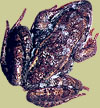
|
|
Frozen
wood frog. [
Click
for a larger image.]
Photo by Dr. Kenneth Storey.
|

Dr. Rubinsky explains how the
old
approach
of attempting to freeze organs for transplant
differs from the new approach.
|

The adaptations of the wood frog and other species led Dr.
Rubinsky to his
new
model
for organ preservation.
|

|
Dr.
Kenneth Story
|
|
|
|

|
Dr.
Boris Rubinsky
|
|
 or
eight years now Rubinsky has sought to understand how the wood
frog survives the formation of ice crystals inside its body. His
efforts have paid off, for he has developed the world's first
technology for preserving organs at subfreezing temperatures.
Rubinsky credits the wood frog with leading him to success by
causing him to reject traditionally accepted paradigms of organ
preservation.
or
eight years now Rubinsky has sought to understand how the wood
frog survives the formation of ice crystals inside its body. His
efforts have paid off, for he has developed the world's first
technology for preserving organs at subfreezing temperatures.
Rubinsky credits the wood frog with leading him to success by
causing him to reject traditionally accepted paradigms of organ
preservation.
In the past, researchers
have often sought to preserve organs by rapidly cooling them to
-200°C in liquid nitrogen. The biggest problem with standard
freezing is that expanding ice crystals wreak havoc upon delicate
tissues, rupturing thousands of microscopic blood vessels and
crushing billions of cells. Such damage is irreparable. But if
cooling occurs quickly enough -- about 1,000°C per minute
-- then water molecules simply don't have time to assemble into
organized ice crystals. According to Rubinsky, the nagging problem
is that organs are simply too large to cool uniformly at 1,000°C
per minute. One could no sooner accomplish this feat than thaw
a 15-pound turkey in a single second -- without either boiling
the turkey's exterior or leaving its insides still half frozen.
So far, no one has solved this problem. Based upon his studies
of the wood frog, Rubinsky has chosen to forsake this approach
in favor of the opposite one: cooling organs more slowly to temperatures
only a few degrees below freezing.

Freeze-tolerant frogs have only recently gained recognition for
their potential contributions to medicine; however, their existence
has long been known. According to Kenneth Storey, a Carleton University
biologist and a relative old-timer to the study of freeze tolerant
vertebrates, the first reports of freeze tolerant frogs came from
18th century European sailors exploring for a Northwest Passage
through what is now Canada.
One such report appears
in the travel log kept by Captain Francis Smith as his ship, the
California, explored near the Arctic Circle. Touching land in
May 1747, Smith noted the emergence of "an infinite Number of
Frogs, with a great croaking." The frogs had passed the winter
frozen in holes in the ground. "A remarkable Experiment," wrote
Smith, "is to take the Earth in which the Frog is so froze, and
to break that Earth in Pieces without thawing it, the Frog will
then break with it as short as a Piece of Glass. But...lay that
Earth at a small Distance from the Fire, so as to thaw it, the
Frog will recover his Summer Activity, and leap as usual."
|